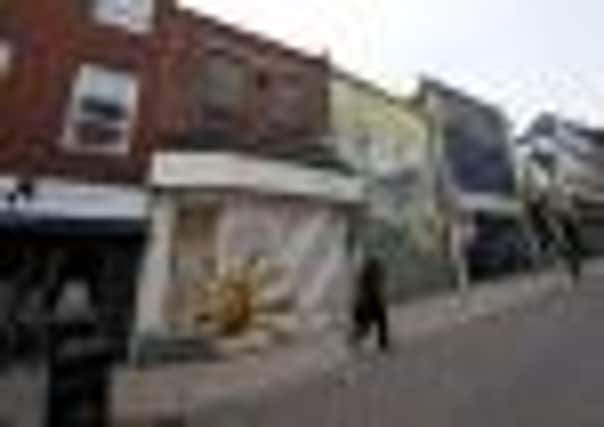Bleak July for retailers as high streets and centres deserted


All types of shopping locations saw reduced footfall year-on-year last month as shoppers faced up to high inflation, low wage growth and uncertainty about future job prospects, according to the British Retail Consortium (BRC).
Vacancy rates were highest in Northern Ireland (17 per cent), followed by Wales (13.4 per cent) and then the North and Yorkshire (13.1 per cent).
Advertisement
Hide AdAdvertisement
Hide AdMore than one in eight stores in the North and Yorkshire are currently vacant, according to the latest BRC statistics.
Falling shopper numbers between May and July were driven by a 1.9 per cent fall in people visiting out-of-town complexes. Many people are ditching their cars at a time of high petrol costs, preferring stores they can walk to near work or home, which explains a 0.6 per cent increase in the number of people visiting shopping centres in town.
The BRC said overall footfall between May and July was one per cent lower than the same period a year earlier.
Out of ten UK regions, only three showed an increase in footfall – Greater London, the South West and Scotland.
Advertisement
Hide AdAdvertisement
Hide AdOf the remaining seven regions Wales was the worst hit with footfall down by 9.2 per cent.
In the North and Yorkshire it was down by 5.5 per cent and the South East was the least badly hit with footfall down 0.5 per cent, lending weight to fears of a North-South split among retailers.
Over the past 12 months high streets saw an average drop in footfall of 2.6 per cent.
The national town centre vacancy rate in the UK was 11.2 per cent, including both high streets and shopping centres.
Advertisement
Hide AdAdvertisement
Hide AdStephen Robertson, British Retail Consortium director general, said: “In July, all types of shopping locations saw reduced footfall year-on-year and that was before the effect of this month’s disturbances in England.
“Fewer people are shopping, but that’s slightly offset by hard-up customers spreading their spending over more but less costly shopping trips.”
This is a trend echoed by Leeds-based Asda which is seeing customers at its newly converted Netto stores visiting up to four times a week as they buy more on their way to or from work rather than making a weekly shopping trip by car.
“This is the first time we’ve been able to publish footfall and vacancy figures in this level of detail and it shows stark differences in retail health between some of the UK’s regions,” said Mr Robertson.
Advertisement
Hide AdAdvertisement
Hide Ad“Generally, the parts of the UK where the public sector is a bigger proportion of the economy are the ones where customer spending is most likely to be hit by worries about job prospects and cuts, meaning people are shopping less and more retail businesses are failing,” he added.
Diane Wehrle, research director at Springboard, which contributed to the research, said: “There has been a shift in activity between different types of shopping areas. Traditionally retail parks and malls outperformed the high street due to ease of access and free parking. However, these areas are now experiencing similar challenges to town centres.”
In addition to the petrol impact, she said the modest 0.6 per cent growth in footfall in shopping centres could be attributed to the early start of summer sales by multiple retailers.
“Shopping centres experienced the largest annual decline in footfall during the same period in 2010 – so their increase in footfall this year starts from a much lower base,” said Ms Wehrle.
Advertisement
Hide AdAdvertisement
Hide Ad“If the trend identified this year continues into 2012 there is a real chance that footfall levels in high streets could stabilise next year.”
The findings echo official figures out last week which revealed slower than expected growth in retail sales.
Retail sales volumes increased month-on-month by just 0.2 per cent in July, compared to a revised 0.8 per cent boost in June, the Office for National Statistics (ONS) said.
Economists had expected a 0.4 per cent rise.
Household goods stores, clothing and footwear shops and non-store retailing, which includes internet and mail order sales, all suffered as cash-strapped consumers reined in their spending.
Advertisement
Hide AdAdvertisement
Hide AdThe retail sector has suffered at the hands of a squeeze on household budgets – driven by muted wage growth and high inflation, which was 4.4 per cent in July, up from 4.2 per cent the previous month.
ASDA MARKS 100TH SMALLER STORE
Asda will open the doors to its 100th smaller format supermarket in York today.
The store in Layerthorpe is one of 66 stores that have been transformed from a Netto.
Asda aims to have 250 Asda Supermarkets open by 2015.
The new store in Layerthorpe joins nine other new supermarkets in Yorkshire with an additional three due to open this week in Malton, Thurnscoe and Goldthorpe. Asda has invested £7m in the area and created more than 160 jobs since it started the smaller-format store openings.